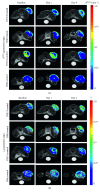Preclinical Molecular Imaging for Precision Medicine in Breast Cancer Mouse Models
- PMID: 31598114
- PMCID: PMC6778915
- DOI: 10.1155/2019/8946729
Preclinical Molecular Imaging for Precision Medicine in Breast Cancer Mouse Models
Abstract
Precision and personalized medicine is gaining importance in modern clinical medicine, as it aims to improve diagnostic precision and to reduce consequent therapeutic failures. In this regard, prior to use in human trials, animal models can help evaluate novel imaging approaches and therapeutic strategies and can help discover new biomarkers. Breast cancer is the most common malignancy in women worldwide, accounting for 25% of cases of all cancers and is responsible for approximately 500,000 deaths per year. Thus, it is important to identify accurate biomarkers for precise stratification of affected patients and for early detection of responsiveness to the selected therapeutic protocol. This review aims to summarize the latest advancements in preclinical molecular imaging in breast cancer mouse models. Positron emission tomography (PET) imaging remains one of the most common preclinical techniques used to evaluate biomarker expression in vivo, whereas magnetic resonance imaging (MRI), particularly diffusion-weighted (DW) sequences, has been demonstrated as capable of distinguishing responders from nonresponders for both conventional and innovative chemo- and immune-therapies with high sensitivity and in a noninvasive manner. The ability to customize therapies is desirable, as this will enable early detection of diseases and tailoring of treatments to individual patient profiles. Animal models remain irreplaceable in the effort to understand the molecular mechanisms and patterns of oncologic diseases.
Copyright © 2019 M. F. Fiordelisi et al.
Conflict of interest statement
The authors declare that they have no conflicts of interest.
Figures





References
Publication types
MeSH terms
Substances
LinkOut - more resources
Full Text Sources
Medical
Research Materials
Miscellaneous
